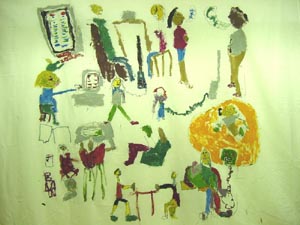
Overview
University Primary School
January – May 2001
Beginning the Project
After four months of being together every school day, the children at University Primary School were feeling comfortable with each other. The curriculum is child-sensitive and responsive to individual patterns of growth, development, learning, and interests. Children have frequent opportunities to work in informal groups on challenging tasks, and to make decisions and choices. They had worked on the Construction Project where in Phase 1, they became experts about what they wanted to know. They were encouraged to think about their ideas. They asked questions, investigated, and researched to find the answers. By January, even though children talked frequently to each other, it was still obvious that some children had difficulty listening to their peers during group discussions.
In order to compare and contrast their points of view, listening to peers is necessary. Exploring Communication became the spring semester’s project of study. During Phase 1 children and teachers shared experiences to uncover what the children already knew about communication. The Head Teacher began the project by sharing stories of a time when she had laryngitis and had to communicate with body language and facial expressions. The Assistant Teacher shared a time when her car broke down and she had to use her cell phone to call for help.
The children shared many stories about listening to books, watching television and talking on the telephone and walkie-talkies. They chose ways to represent what they already knew. They drew, surveyed and made 3-dimensional models of communication devices with clay, Legos and boxes and junk.

KK and JM proudly showing their clay
representations of a cell phone.
The teacher and class brainstormed words associated with communication that were categorized to form a web. The children raised questions that they wanted to find out about communication. The teachers and students categorized their questions and reformulated them to form small study groups. Question that gave direction to Phase 2 of the project included:
- What is communication and what are the ways to do it?
- What are the ways to send messages and how do they work?
- What are the ways to receive messages?
- How does sound travel?
- What types of communication are codes, emergency signals and other languages?
Developing the Project
The children engaged in field studies to answer their questions. They took walking trips to look for ways of communication. They also went to the post office, Fire Training Institute, emergency storm signal site, TV studio, and Beckman Institute. They invited experts into the class to answer their questions. Visitors included an audiologist, a manager of a telephone distribution store, two undergraduate scientists, one undergraduate computer programmer, a flutist, a saxophone ensemble and several parents. Parents included a football player who shared his team codes, a physicist, and a scientist. Parents also served as foreign language instructors and facilitators of resources. One parent arranged for a percussion ensemble performance. Another parent brought twin babies into the classroom to answer one child’s question, “How do babies learn to talk?”

Children listened to sounds that have been received through
a satellite.
When they walked to different places on the grounds of the Beckman
Institute, they heard a variety of sounds coming from different sources.
Before each field study trip, students predicted what they might find. During field studies the children collected data by making observational drawings, collecting artifacts, taking photographs, and writing answers to their questions that were answered by the experts. Writing opportunities included note taking, experience stories, letters, poems, books and writing captions to photographs or drawings. Children formulated many surveys and organized data into tally charts and graphs.
|
|
In addition, they created part to whole charts and discussed and drew the inside of a computer. Many discussions occurred in whole group meetings where the children could listen, question, comment and enjoy each other’s work. The conversations and interactions helped children gain new understandings about communication.
Concluding the Project
To share their new understandings and findings about communication, the children invited their parents and families to the Spring Open House. The teachers discussed with the students, “What was important about the study of communication?” Themes emerged. The children wrote a song and five plays. Groups of children signed up to draw and paint a fabric mural. One group of children made cardboard stand-ups of people talking. Another group created a large model of a computer.

CO representing the keyboard to put
with her model of a computer.
The teachers created a questionnaire for parents to ascertain how much their children transferred their new understandings from school to home. All enjoyed the afternoon as the class celebrated their learning with their families.
What did the Children Learn?
The children were encouraged to relive, review and remember their experiences communicating. They continued to strengthen their disposition to observe closely and continued to grow in representing their ideas. They practiced framing questions to clearly articulate what they wanted to know. They understood more clearly what communication entailed and gained knowledge about how sound travels and how we receive messages. They were introduced to fields of study that included telecommunications, physics, computer science, music, foreign language, speech and hearing, and sports. They worked on understanding how sound travels by telephone and how computers send messages.

AK describes how she thinks sound travels.
"Sound and a vibration tower."
The children tried harder to listen to each other and to appreciate others’ ideas, to pose questions for clarification, and to better articulate disagreements. They used communication terminology in conversation and learned to communicate in foreign languages, sign language, music and mime. The children enjoyed the engagement in conducting investigations that answered their questions. They continued to verbalize predictions and hypotheses as well as utilized graphic organizers to display their data. They applied their problem-solving skills to take leadership roles in the classroom. They used mathematical and critical thinking as they created models to represent actual computers and people. They once again gained an appreciation for the complexity and depth of a project, and came out of the study with even more detailed questions that they wanted to pursue. Their disposition to inquire continued to strengthen.
|
|
 |
||
|
STUDYING
CONSTRUCTION |
EXPLORING
COMMUNICATION |
© 2001. University
Primary School. Department of
Special Education. University of Illinois.
All rights reserved. Credits.





